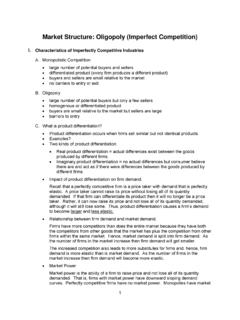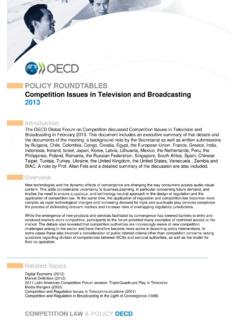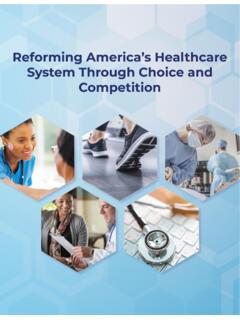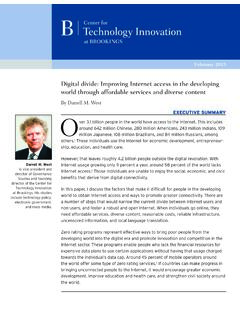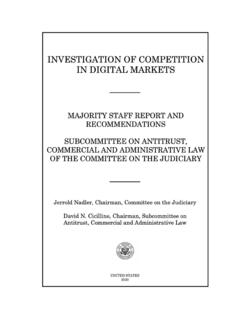Transcription of Airport Business Practices and their Impact on Airline ...
1 Airport Business Practices AND their Impact ON Airline competition FAA/OST Task Force Study October 1999 C O N T E N T S Page EXECUTIVE SUMMARY i Chapter 1: Overview of the Airport System 1 Airport Ownership and Management 2 Airport Funding 3 Airport Leasing Arrangements 7 Scope and Methodology 9 Chapter 2: Airports' Legal Obligation to Provide Reasonable Air Carrier Access in Support of competition 13 Airport Operators Must Provide Reasonable Access and Not Engage in Economic Discrimination 15 Terms and Conditions 18 Prohibition Against Exclusive Rights 21 Federal Preemption 23 Airport Proprietary Powers 24 Unfair Airline competition 26 Chapter 3: Airport Access and Its Effects on Airline competition 29 Access to Airports Is Critical to Airline competition 30 Contractual Arrangements Between Airports and Airlines Can Influence competition 33 Contractual Arrangements Do Not Preclude Reasonable entry 49 Chapter 4: Using Passenger Facility Charges to Enhance competition 53 PFCs: A Potentially Significant Tool for Increasing competition 54 PFC Funding Has Contributed to Overall Airport Funding,Steps Needed to Better Understand the Competitive Benefits of But Its Competitive Impact Is Unclear 58 PFC-Funded Projects 64 Airport Business Practices and their Impact FAA/OST Task Force On Airline competition October 1999 Page Chapter 5.
2 Airport Management Practices and Successful Airline entry 69 Airport Managers Play a Critical Role in the Success or Failure of Air Carriers 69 Some Communities Are Reviewing Airport Business Practices toAirports Can Promote competition by Adopting Practices Already in Improve Opportunities for New Airline entry 71 Use at Other Airports 76 APPENDIX A . Gate Usage Practices at Individual Large and Medium Hub Airports, 1992, 1998 and 2004 85 APPENDIX B. Type of Financing Arrangements and MII Status at Individual Large and Medium Hub Airports, 1998 91 Airport Business Practices and their Impact FAA/OST Task Force On Airline competition October 1999 EXECUTIVE SUMMARY INTRODUCTION Air Carrier Complaints Airline deregulation has generated substantial economic benefits for the vast majority of the traveling public.
3 Lower average airfares (after adjusting for inflation) and better service for most consumers have increased the demand for air travel. Despite deregulation s overall success, however, questions continue to be raised as to whether competition in certain air travel markets is as vigorous as it could be. Academic and government studies continue to find the existence of substantial airfare premiums, particularly at concentrated hub airports where new entrant and low-fare airlines have had problems establishing a strong market presence. As barriers to entry , the General Accounting Office and other observers have pointed to airports long-term, exclusive-use gate-lease agreements with tenant airlines and to majority-in-interest (MII) clauses, which give signatory airlines special rights to approve Airport capital improvement plans. Recently, the Transportation Research Board concluded that limited access to Airport gates can be an obstacle to entry that merits close monitoring by Airport operators and the Department of Transportation (DOT).
4 1 Furthermore, at Congressional hearings and in comments to DOT officials, representatives of new entrant and incumbent air carriers report that they face the following conditions in gaining access to critical facilities, particularly at certain heavily used airports: Lack of assistance from Airport management in obtaining access to gates or in arranging sublease agreements with primary tenant airlines. Inconvenient and frequent gate reassignments in circumstances not favorable to the operational needs of new tenants. 1 entry Conditions in the Airline Industry: Issues and Opportunities, Report of the National Research Council s Transportation Research Board (August 1999), p. 3-19 (advance copy). Airport Business Practices and their Impact FAA/OST Task Force On Airline competition October 1999 EXECUTIVE SUMMARY Page ii Access Is Essential Classification of new entrants as non-signatory carriers despite their willingness to lease gates and become signatory carriers.
5 Fee differentials for gates and other facilities at the same Airport . Lack of access to a gate except at the least desirable times. Bundling of facilities and ancillary services when a new entrant subleases a gate ( , the subleasing air carrier must use the ground-handling services of the primary tenant Airline ). Inability of new entrants to have new facilities constructed at airports due to the opposition of signatory air carriers, as well as their ability to delay or prevent Airport capital-development projects through MII clauses. Lack of priority for gates and other facilities, since these are offered first to dominant airlines at airports rather than to new entrants. Uncertainty regarding what the Airport requires to obtain a gate or to expand operations at the Airport . Airline deregulation can work well only if market forces can discipline the pricing behavior of all air carriers.
6 As documented in numerous academic and government reports, significant new entry in concentrated Airline mar-kets results in lower airfares, often dramatically lower. But if airlines cannot gain access to gates, baggage claim areas, passenger check-in and hold rooms, and other essential Airport facilities on reasonable terms, they will be unable to compete successfully against air carriers that do have such access. Moreover, unless there is a reasonable likelihood that a new entrant s short-term and long-term needs for gates and other facilities will be met, it may simply decide not to serve a community. Airport Business Practices and their Impact FAA/OST Task Force On Airline competition October 1999 EXECUTIVE SUMMARY Page iii Task Force To address the issue of how Airport Business Practices affect Established Airline competition , Secretary Slater established a Task Force jointly staffed by the Office of the Secretary (OST) and the Federal Aviation Administration (FAA).
7 This report presents the results of the Task Force study, including actions for immediate implementation by the Department and issues for further consideration by the Congress, industry and DOT. RESULTS IN BRIEF Airport Business Practices The Task Force focused on two basic questions: Are certain Airport Business Practices discouraging or preventing entry by new air carriers or hindering competition among the carriers already operating at an Airport ? What has been the Impact of Passenger Facility Charges on Airport capacity and Airline competition ? Airport Business Practices play a critical role in shaping Airline competition . Access at many of the Nation s most heavily used airports is limited, not only because of airside constraints, but also because of long-established Airport Business Practices . The financial viability of an Airline , especially a new entrant Airline , may depend on serving a few key Business and leisure markets.
8 But such service requires access to Airport gates and other facilities on reasonable terms. Airport managers often cite long-term, exclusive-use gate-lease agreements with incumbent airlines as one Business practice that makes it difficult for new entrant air carriers to begin serving an Airport . While Airport Business Practices can limit the ability of Airport managers to assign gates and other critical facilities to new entrant airlines, Airport manag-ers have a legal obligation to accommodate all qualified airlines that wish to serve their Airport . (An Airport may adopt reasonable and nondiscriminatory minimum standards Airport Business Practices and their Impact FAA/OST Task Force On Airline competition October 1999 EXECUTIVE SUMMARY Page iv Passenger Facility Charges to ensure safe and efficient Airport operation; such standards may include creditworthiness, for example).
9 Stated simply, Airport managers cannot allow dominant airlines to become de facto Airport managers. The Department, meanwhile, must be vigilant in assuring that all airports meet their legal obligations to accommodate all qualified airlines. Passenger Facility Charges (PFCs) have played an important role in financing Airport capital development projects. Between 1992 and 1998, FAA approved 3,900 projects and authorized collection of PFCs totaling almost $19 billion. (By January 1999, approved funding reached $23 billion.) Several projects allowed Airport operators to build or refurbish terminals and gates, and thus accommodate new entrant air carriers or incumbent carriers that wanted to expand their operations. However, due to a lack of data regarding the effects of PFC-financed projects on new entrant usage, and because many terminal projects have not yet come on line, the extent to which PFCs have had a direct effect on enhancing Airline competition is not clear.
10 Changes to the PFC Program are needed before its full competitive potential is achieved. SCOPE AND METHODOLOGY To gather information on Airport Business Practices and the Impact of PFCs, the Task Force obtained information from the public and the Airport and Airline communities. Task Force staff also worked closely with the Airports Council International-North America (ACI-NA), which developed a questionnaire on Airport capacity, operations, and Practices . Finally, Task Force members visited 13 large airports to gain information about Airport Practices and Airline competition . Public Comments The Task Force provided several opportunities for the public, the aviation industry, and the Airport community to provide input to the study. On April 10, 1998, DOT published a request for comments in the Federal Register. Comments were collected and filed in a public docket (Docket No. OST-98-4025).












